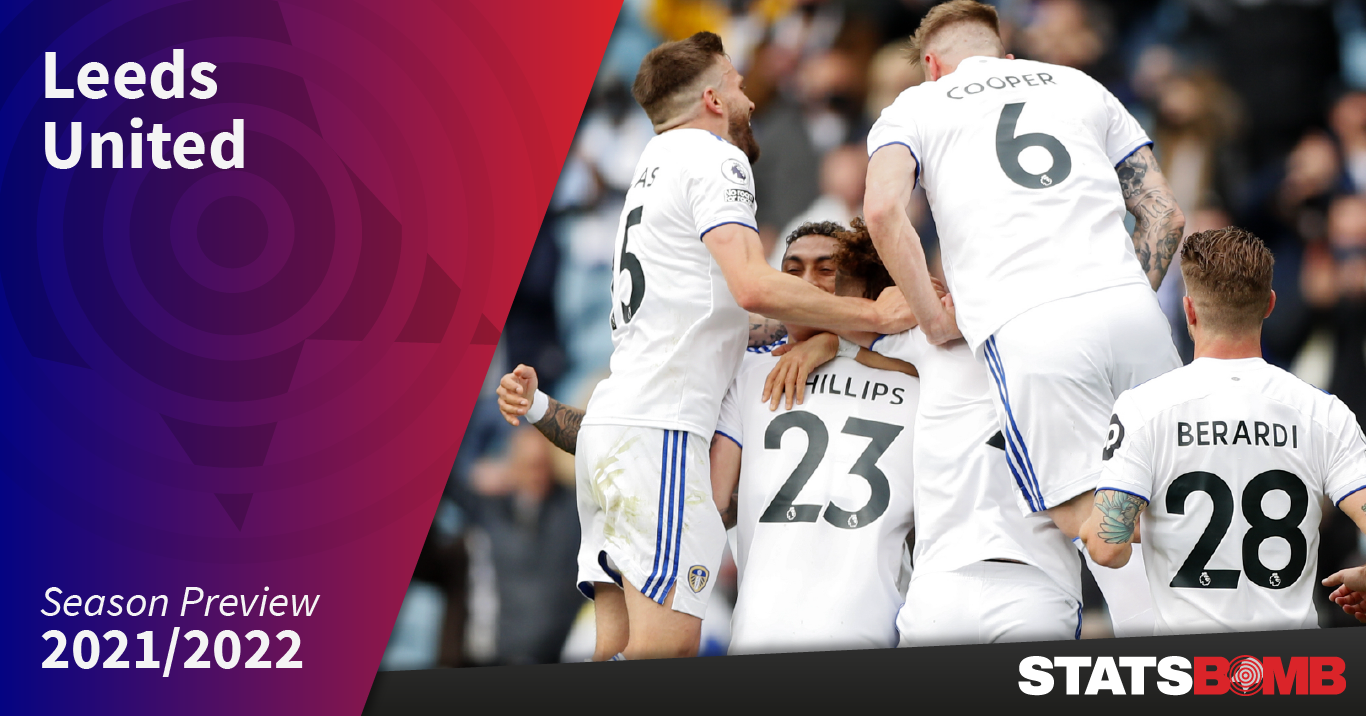Heading into last season, it seemed that Marcelo Bielsa’s sense of goodwill amongst Leeds United fans couldn’t get any higher. A return to the Premier League for the first time since 2004, some incredible football in the Championship, and a sincere mutual appreciation with the fanbase. But after a top-half finish in 2020/21 and continued entertainment against some of the biggest teams in the country, it looks like Bielsa’s status has elevated even further. The storylines to look out for next season circle around their production at both ends of the pitch. How do they stabilise their attacking unit whilst improving their defensive metrics?
Setting the Scene - Attacking Strength
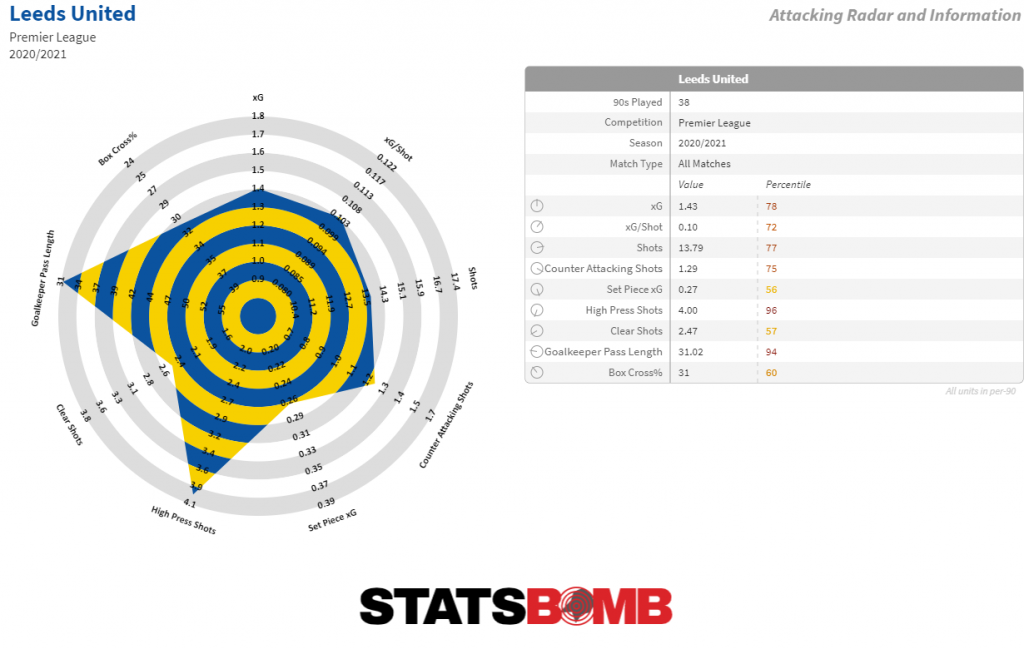
Looking at last season, the attacking metrics were exceptional: above the 75th percentile in the big 5 leagues for all of xG per 90; xG per shot; shots taken following a high press; attacking pace towards goal; and clear shots on goal (shots with just the goalkeeper between the shooter and the goal). Anyone who watched Bielsa’s team last season won’t be surprised by these benchmarks: Leeds carried over the high intensity, high tempo, adventurous attacking style which tore the EFL Championship apart in 2019/20.
A style which has become his hallmark since moving to the Whites, although it has been consistent with his philosophy over the years: verticality in attacking, rotational interchanges, third man combinations etc, etc. In possession, Leeds are committed to building from the back, with goalkeeper Illan Meslier impressing last season with his ability to contribute in the first phase of buildup. They create space in this phase by positioning their advanced midfielders high up the pitch and creating width with their full backs, pinning the opposition deeper and therefore freeing Leeds to create and make the types of passes shown below:
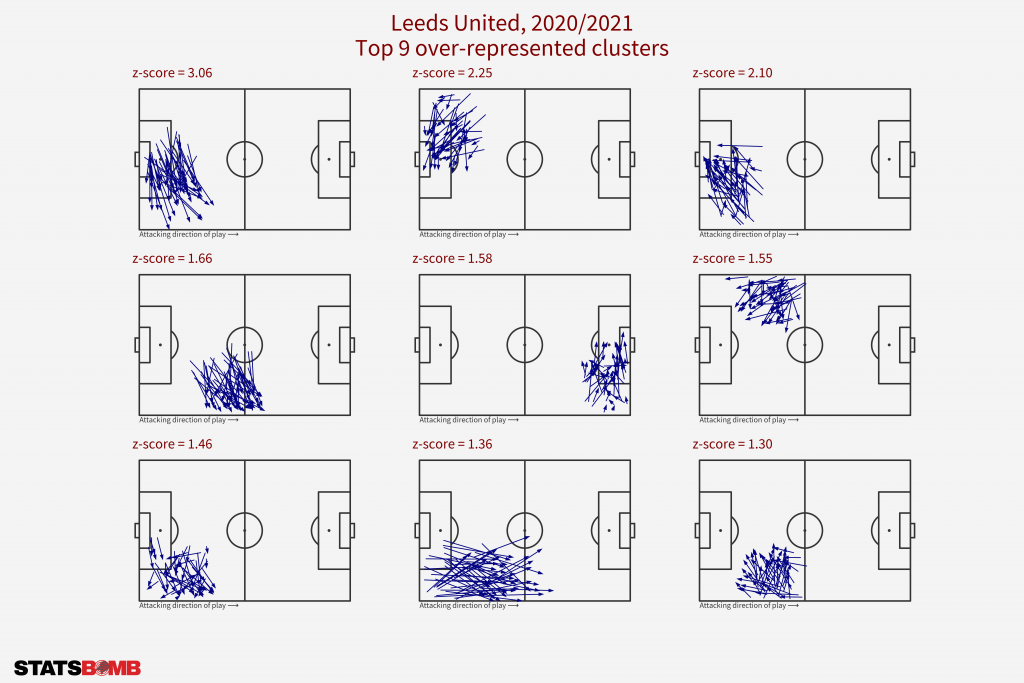
When it comes to playing into the attacking third and chance creation, Leeds are extremely vertical in their intentions, leading to quick attacking moves, few wasted passes in the final third, and lots of possession shifts.
| Directness | 88% (6th) |
| Pace Towards Goal | 2.8 m/s (6th) |
| Deep Progressions per 90 | 43.7 (8th) |
| Possessions per 90 | 197.4 (1st) |
The key players in this style are the wide players, who facilitate a lot of goalscoring opportunities. Whether it be running at a stretched defence or receiving in pockets in the final third against more settled blocks, it’s the wide players who fare best for Leeds in our new possession value model, On-Ball Value (OBV).
OBV rates every action on the pitch and estimates the extent to which each action improves a team's expected goal difference over the next two possessions. Jack Harrison and Raphinha were clearly effective players by the eye test and in the OBV model, and it’s imperative they generate similar numbers if Leeds’ attack is to continue to impress in the new season.
Patrick Bamford, long time analytics darling, didn’t have another frustrating season in terms of underperforming xG, and some of that can be attributed to how Leeds’ wide players took a load of him in terms of goal creation, not to discount his evident Premier League ability.
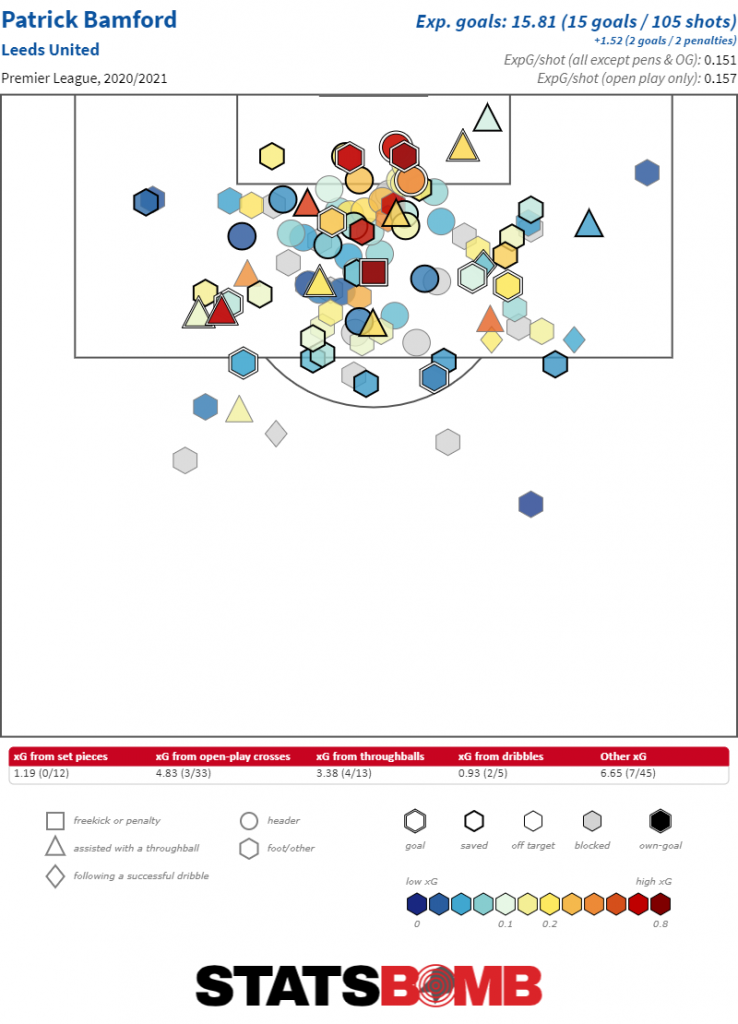
The Double-Edged Sword - Leeds In Defence
Where their defensive pressing style had been nearly impossible to play against in the Championship, it at times left them overexposed in the Premier League. Leeds really struggled to prevent the opposition from creating chances last season, and their defensive style is so unique that it’s worth investigating into the specifics of the tactics that could be the root cause of the issues.
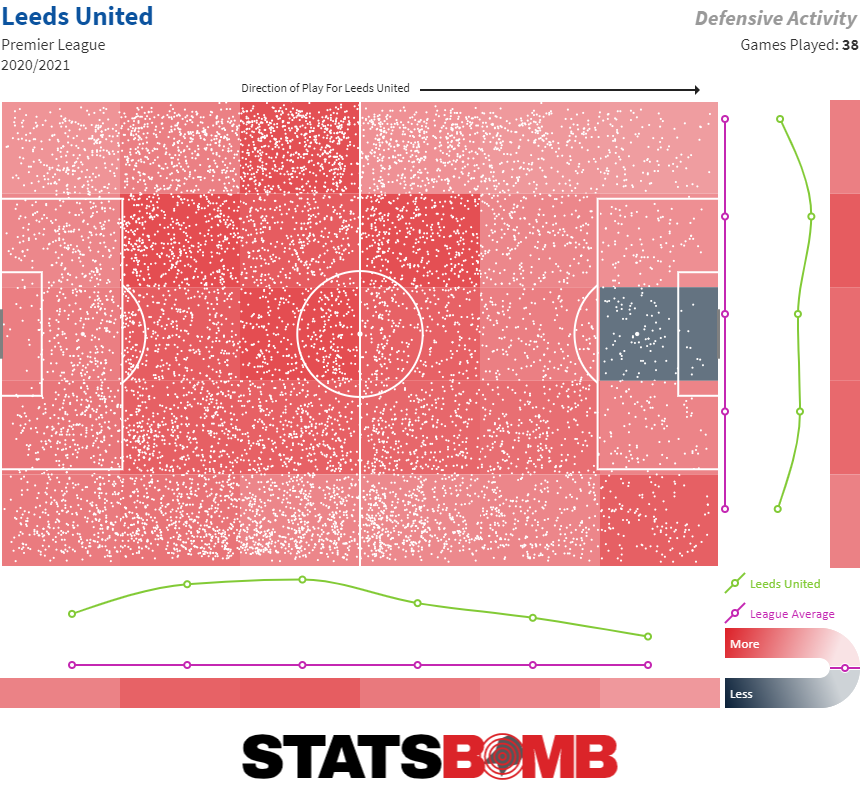
First, how they press and defend in the opposition’s half. Leeds employ a heavy, man-oriented pressing system - the most aggressive in the division. Their principles are generally ball-oriented in that they focus their position based on the ball position rather than the opposition players, but in how this manifests itself structurally, they are man-to-man: each player is tasked with an opponent to pick up, which makes their responsibilities very straightforward.
Without getting too deep into the tactical weeds, this creates variations in how their forward players put pressure on an opponent’s buildup since they are -1 up front: 3v2 if they play a back three, and 3v4 if the opposition use a back four.
Either way, this strategy of keeping opponents as far from goal as possible to stop them from getting into the Leeds half has been successful: they conceded the 5th-fewest deep progressions in the Premier League last season. The issues started to arise when the opponent broke the press or when Leeds had to defend in more traditional “blocks”. They conceded 1.48 xG per 90 (18th in the league), 14.5 shots against per 90 (17th), and were vulnerable to being pressed high and hurt in transition, conceding shots from those situations at similarly relegation-level rates.
The same reasons they’re so effective in attack that were highlighted in the attacking section – pushing players ahead of the ball, stretching the defence wide, making adventurous rotations – are the same reasons they struggle defensively; they’re left overexposed.
Combine that with a talent deficit, less of an issue in Leeds’ case but still an issue in newly promoted clubs, and you’re going to leave yourself open, something that Bielsa will surely be working on into next season. While it was an enforced change thanks to injuries in midfield, Stuart Dallas played a very good role in helping solidify the deeper areas directly ahead of defence compared to his peers.
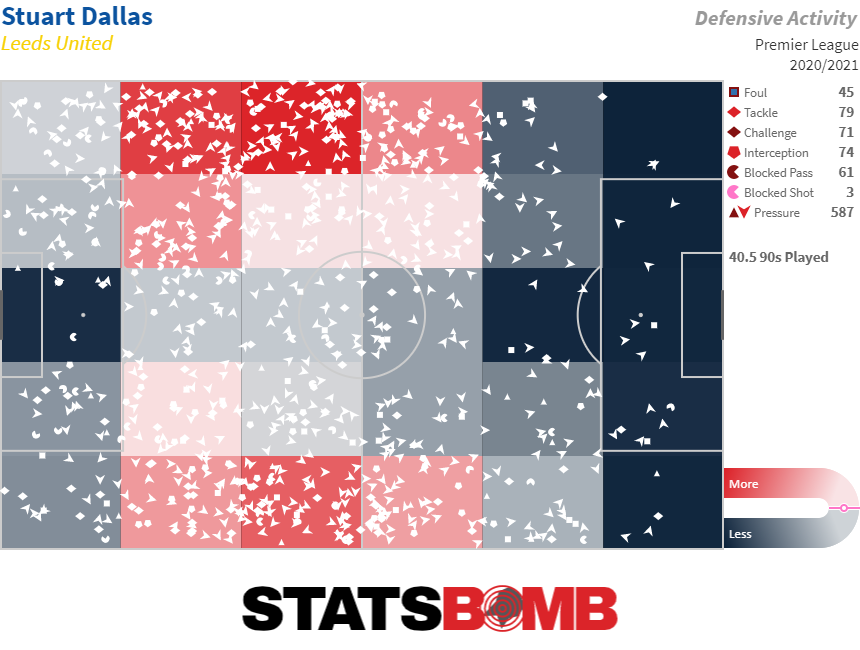
Set-pieces have been something of an achilles heel to Leeds ever since the Championship days, particularly corners. This is thanks (or no thanks!) to a combination of player profile and tactical setup. For one, Bielsa’s sides defend corners in an almost-exclusively man-to-man system. Only one player (usually Bamford across the near post) acts zonally and could be regarded as “free”. Similar to their defending in open play, this puts a lot of responsibility on the individual to win their 1v1 battle.
That said, the advantage will always be with the attacking team on dead balls: concepts such as picks, blocks, and screens mean you can isolate players free of their markers and create clear-cut chances. Without many “fail safes” to defend against this (i.e zonal players), you’re leaving yourself prone to these manoeuvres and manipulations.
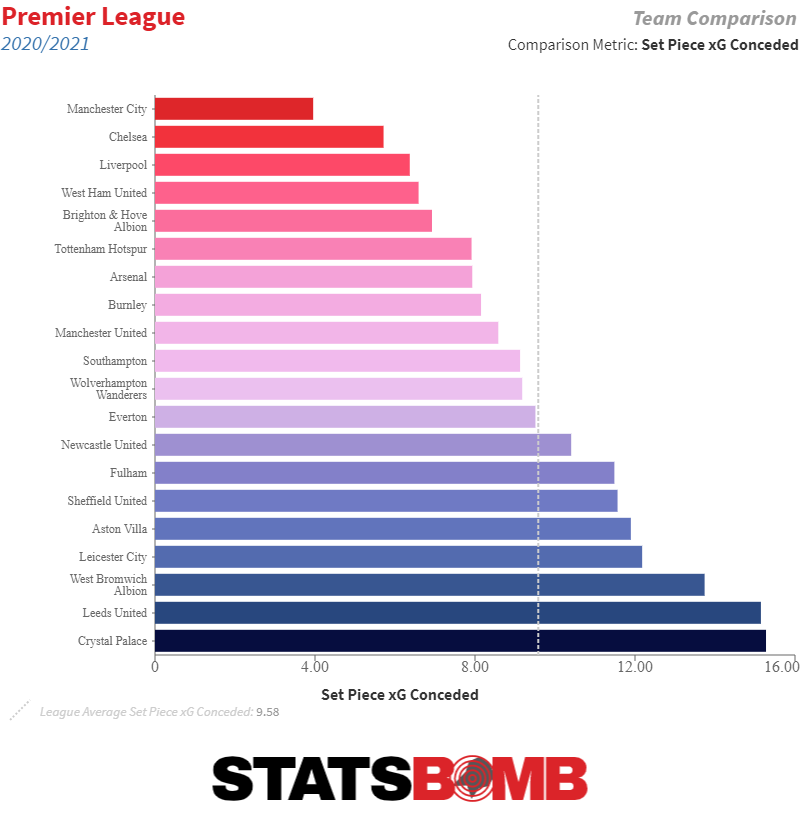
Transfers
As with most teams this summer, incomings have been slow at the time of writing. One of the positive bits of transfer business has been to convert Jack Harrison’s loan into a permanent contract after three seasons on loan from Manchester City. The winger was a significant contributor off the left last season: coming in with an OBV per 90 of 0.31, placing him in the 71st percentile for players in his position in the Premier League. At £11million, this was a no-brainer.
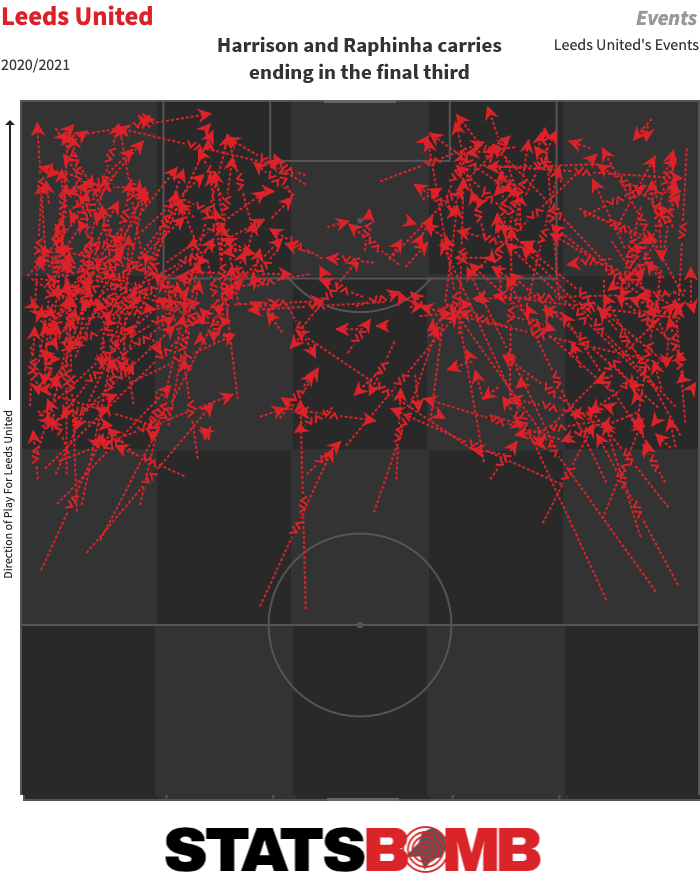
Junior Firpo has come in from Barcelona to replace the outgoing Ezgjan Alioski at left back. Firpo found game time few and far between in La Liga, but his profile certainly fits the type of defender who should fit the Leeds system. Firpo is primarily a threat when attacking space from deep and arriving into the final third, and represents a tangible upgrade on Alioski in terms of buildup play, ranking favourably in xG Buildup throughout his career. Patience could be required defensively as any player faces a period of adaptation when they first join a Bielsa side, but he certainly fits the physical profile to make the jump successfully.
Talking potential additions now: the Leeds support have been clamouring for an addition in the centre of midfield. We spoke earlier of Stuart Dallas’ move into the centre of the park that helped to solidify the defensive shortcomings Leeds were struggling with, but this doesn’t feel like a long-term solution. With Kalvin Phillips’ place in the XI under no doubt, Leeds will be looking to sign a player capable of providing pressing and ball-winning while also being able to play in pockets of space and higher up the pitch. Links with Huddersfield Town midfielder Lewis O’Brien have lingered all summer, and he certainly fits the profile of a player that could contribute those aspects.
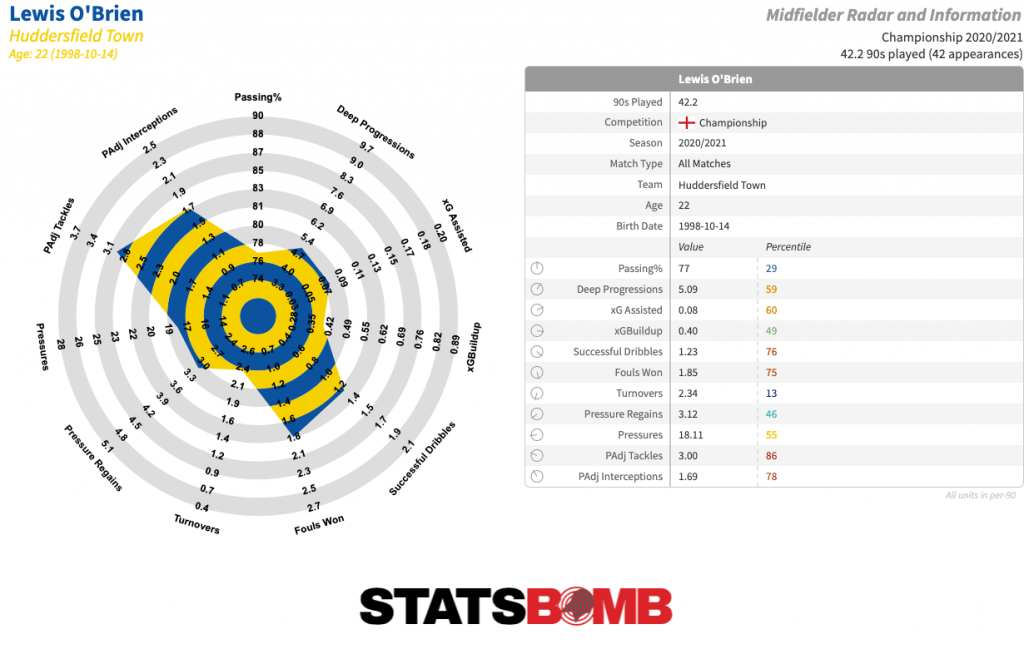
European Hopefuls?
As a newly promoted side, Leeds had an exceptional 2020/21 season to finish 9th. Which makes projecting their placement next season tricky – it’s a challenging benchmark to repeat with teams above them in the table some of the biggest and most well-backed in the world.
The blueprint for improvement is clear: maintain the attacking output while tightening up defensively. Achieve this, and they could well embark on a West Ham-esque challenge for the Europa League places. We know Bielsa won’t change his style, so the question is whether Leeds can bolster and strengthen their ranks enough before the transfer window closes.
Either way – it’s going to be fun!
Want to read about another team?
The rest of our Premier League season previews can be found here
If you're a club, media or gambling entity and want to know more about what StatsBomb can do for you, please contact us at Sales@StatsBomb.com
We also provide education in this area, so if this taste of football analytics sparked interest, check out our Introduction to Football Analytics course
Follow us on Twitter in English and Spanish and also on LinkedIn
